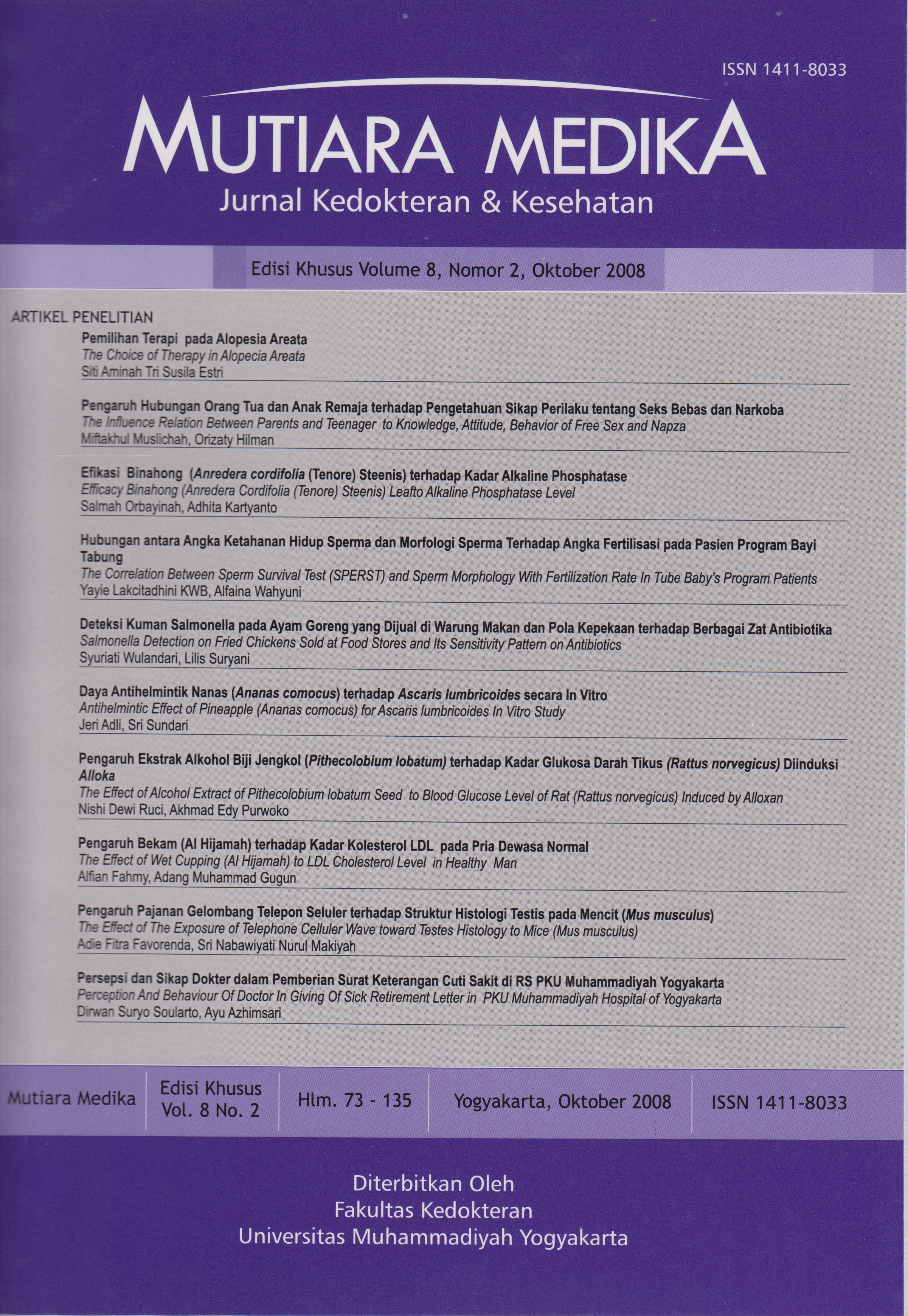Deteksi Kuman Salmonella pada Ayam Goreng yang Dijual di Warung Makan dan Pola Kepekaan terhadap Berbagai Zat Antibiotika
DOI:
https://doi.org/10.18196/mmjkk.v8i2%20(s).1632Keywords:
warung makan, Salmonella typhi, Salmonella paratyphi, zat antibiotika, antibiotic, food storesAbstract
There are many types of bacteria that cause food poisoned. One of the bacterias is Salmonella typhi. This type of bacteria mostly inhabit the farm animals or wild animals. Mostly bacterias on cats, dogs, rats, flies and cockroaches defile chickens, meat, eggs and raw milk. Salmonella typhi defiles riped foods during storage and serving. Researches meant to detect Salmonella presence on foods sold at restaurants in Yogyakarta are rarely conducted. This research was in demand to find out the safety of the restaurant foods. This research is a retrospective research. The 5 (five) samples tested were fried chickens sold at restaurants along the Patang Puluhan street, Wirobrajan, Yogyakarta. The identification process was proceeded at Laboratorium Mikrobiologi Fakultas Kedokteran UMY on August 2007. The process included bacteria quantity determination, Salmonella typhi and Salmonella paratyphi identification and sensitivity pattern of both bacteria on antibiotics. The bacteria count test result shows 6612 organism/ml. And that 60% of the fried chicken sample is contaminated with Salmonella typhi, 20% contaminated with Salmonella paratyphi, and 20% contaminated with E. Coli. The antibiotics that still can be used to exterminate Salmonella typhi are Cotrimoxazol and Ciprofloxacin, for Salmonella paratyphi are Amoxicillin, Cotrimoxazol, Seftriaxon and Ciprofloxacin.
Banyakjenis kuman yang dapat menyebabkan keracunan makanan dan salah satunya adalah Salmonell typhi. Kuman ini didapat dari hewan peliharaan atau hewan liar. Biasanya pada kucing, anjing, tikus, lalat dan kecoa yang mencemari ayam, daging, telur dan hasil telur, susu mentah. Salmonella typhi mencemarkan makanan melalui makanan yang telah dimasak ketika penyediaan dan penyimpanan. Penelitian ini dilakukan untuk deteksi Salmonella pada makanan ayam goreng yang dijual pada warung makan di Yogyakarta, dengan tujuan untuk mengetahui keamanan makanan yang dijual para pedagang. Penelitian ini bersifat retrospektif. Sampel yang diuji berupa ayam goreng yang dijual di warung makan di sepanjang jalan Patang Puluhan Wirobrajan Yogyakarta sejumlah 5 sampel. Identifikasi dilakukan di Laboratorium Mikrobiologi FK UMY pada bulan Agustus 2007. Identifikasi meliputi penentuan jumlah kuman, identifikasi Salmonella typhi dan Salmonella paratyphi, serta pola kepekaan kedua kuman tersebut terhadap berbagai zat antiboitika. Hasil penelitian menunjukan bahwa hasil penentuan angka kuman diperoleh 6612 organisme/ ml. 60% sampel ayam goreng yang dijual di warung makan terkontaminasi Salmonella typhi. 20% sampel ayam goreng yang dijual di warung makan terkontaminasi Salmonella paratyphi. 20% sampel ayam goreng yang dijual di warung makan terkontaminasi E.coli. Zat antibiotika yang masih poten untuk membunuh kuman Salmonella typhi adalah Kotrimoksazol dan Ciprofloksasin. Salmonella paratyphi adalah Amoksisilin, Kotrimoksazol, Seftriakson, dan Ciprofloksasin.
References
Jamaluddin, Norlaila hamima. (2007). keracunan makanan. Diakses 20 juli 2007 dari http://www.hmetro.com.my/ current News/HM/sunday/ Kesihatan/ 20070325105858/article/indexs_html
Jawetz.,Melnick.,Adelbergs.(2001). Mikrobiologi Kedokteran. Jakarta : Salemba Medika
Pracoyo, Noer E.,Harjtning S., Pujarwoto T., (1993).Penelitian kuman- kuman pathogen dalam makanan catering di Jakarta.Cermin Dunia Kedokteran
Gabriela J., Jarmila P., Katerina D. (2000).Detection of Salmonella in food samples by the combination of immunomagnetic separation and PCR assay. Czech Republic: INTERNATL MICROBIOL
Katzung, BG.(1998).Farmakologi dasar dan klinik ed:VI Jakarta:EGC
Downloads
Published
Issue
Section
License
Copyright
Authors retain copyright and grant Mutiara Medika: Jurnal Kedokteran dan Kesehatan (MMJKK) the right of first publication with the work simultaneously licensed under an Attribution 4.0 International (CC BY 4.0) that allows others to remix, adapt and build upon the work with an acknowledgment of the work's authorship and of the initial publication in Mutiara Medika: Jurnal Kedokteran dan Kesehatan (MMJKK).
Authors are permitted to copy and redistribute the journal's published version of the work (e.g., post it to an institutional repository or publish it in a book), with an acknowledgment of its initial publication in Mutiara Medika: Jurnal Kedokteran dan Kesehatan (MMJKK).
License
Articles published in the Mutiara Medika: Jurnal Kedokteran dan Kesehatan (MMJKK) are licensed under an Attribution 4.0 International (CC BY 4.0) license. You are free to:
- Share — copy and redistribute the material in any medium or format.
- Adapt — remix, transform, and build upon the material for any purpose, even commercially.
This license is acceptable for Free Cultural Works. The licensor cannot revoke these freedoms as long as you follow the license terms. Under the following terms:
Attribution — You must give appropriate credit, provide a link to the license, and indicate if changes were made. You may do so in any reasonable manner, but not in any way that suggests the licensor endorses you or your use.
- No additional restrictions — You may not apply legal terms or technological measures that legally restrict others from doing anything the license permits.






